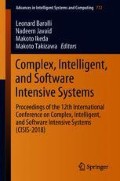Abstract
This paper presents the results of a feasibility study of a deep learning scheme for sign language motion recognition. Capturing the motions used in sign language was conducted using specially designed colored gloves and an optical camera. Deep learning and conventional classification schemes were used for motion recognition, and their results are compared. In a deep learning process each frame of motion data is passed directly to AlexNet for feature extraction. Although the structure of the neural network and optional parameters for deep learning have not been optimized at this stage, it was verified that the accuracy of recognition ranged from 59.6% to 72.3% for twenty-five motions. Though this performance is inferior to that of conventional schemes, it is considered that these results indicate the feasibility of using a deep learning scheme for sign language motion recognition.
Access this chapter
Tax calculation will be finalised at checkout
Purchases are for personal use only
References
Baatar, B., Tanaka, J.: Comparing sensor based and vision based techniques for dynamic gesture recognition. In: The 10th Asia Pacific Conference on Computer Human Interaction (APCHI) (2012). Poster 2P-21
Zafrulla, Z., Brashear, H., Starner, T., Hamilton, H., Presti, P.: American sign language recognition with the Kinect. In: Proceedings of the 13th International Conference on Multi-Model Interfaces, pp. 276–286 (2011)
Jitcharoenpory, R., Senechakr, P., Dahlan, M., Suchato, A., Chiangsuwanich, E., Punyabukkana, P.: Recognizing words in Thai Sign Language using flex sensors and gyroscopes. In: i-CREATe2017, 4 p. (2017)
Ozawa, T., Shibata, T., Nishimura, H., Tanaka, T.: Investigation of sign language recognition performance by integration of feature elements and performance improvement for sign language recognition by Hidden Markov Model. LNCS, vol. 10278, pp. 77–88 (2017)
Visual Object Classes Challenge 2012 (VOC2012). http://host.robots.ox.ac.uk/pascal/VOC/voc2012/
Japanese ASL Signers Society. http://is.npojass.org/
Signing Savvy, ASL Sign Language Video Dictionary. https://www.signingsavvy.com/
KCC Corporation, SmartDeaf. http://www.smartdeaf.com/
Okayasu, Y., Ozawa, T., Dahlan, M., Nishimura, M., Tanaka, H.: Performance enhancement by combining visual clues to identify sing language motions. In: IEEE Pacific Rim Conference, 4 p. (2017)
Krizhevsky, A., Sutkever, I., Hinton, G.E.: ImageNet classification with deep convolutional neural networks. In: Advances in Neural Information Processing Systems, pp. 1097–1105 (2012)
Author information
Authors and Affiliations
Corresponding author
Editor information
Editors and Affiliations
Rights and permissions
Copyright information
© 2019 Springer International Publishing AG, part of Springer Nature
About this paper
Cite this paper
Sakamoto, K., Ota, E., Ozawa, T., Nishimura, H., Tanaka, H. (2019). Feasibility Study on Deep Learning Scheme for Sign Language Motion Recognition. In: Barolli, L., Javaid, N., Ikeda, M., Takizawa, M. (eds) Complex, Intelligent, and Software Intensive Systems. CISIS 2018. Advances in Intelligent Systems and Computing, vol 772. Springer, Cham. https://doi.org/10.1007/978-3-319-93659-8_103
Download citation
DOI: https://doi.org/10.1007/978-3-319-93659-8_103
Published:
Publisher Name: Springer, Cham
Print ISBN: 978-3-319-93658-1
Online ISBN: 978-3-319-93659-8
eBook Packages: Intelligent Technologies and RoboticsIntelligent Technologies and Robotics (R0)

